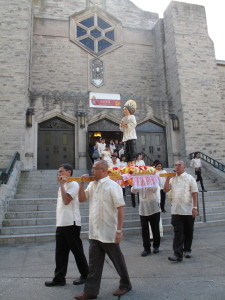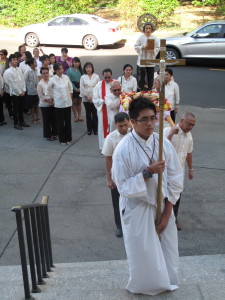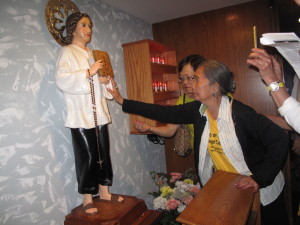by Antonina Zielinska
The first Filipino saint, St. Lorenzo Ruiz, now holds a prominent place in Mary’s Nativity Church, Flushing.
Auxiliary Bishop Raymond Chappetto blessed the new statue of St. Lorenzo, which stands in a shrine surrounded by candles at the front of the church.

“St. Lorenzo reminds us of the vocation we all have, the vocation to sainthood,” he said during the Sept. 15 Mass he celebrated with the Mary’s Nativity-St. Ann parish community. “Each of us is asked in our own way, each and every day, to follow God’s path.”
St. Lorenzo was born in the Philippines at the turn of the 17th century to a Filipino mother and a Chinese father, both devout Catholics. He was educated by the Dominicans and offered many services to the religious community. When he grew older, he served as an official calligrapher for the Church and for private individuals. He was married and had three children.
However, he had to flee from his home and family when he was accused of murdering a Spaniard, an offense to the crown. He sought refuge with the Dominicans on a ship he thought was on a mission to Formosa, modern-day Taiwan.
In reality, the craft was headed to Nagasaki, Japan, where Christianity has been recently outlawed and Christians were being harshly persecuted. Although the friars wanted to find him safe passage to Formosa, he feared the Spanish officials would find and execute him.
He stayed with the Dominicans and was arrested with them after they landed in Japan. Among the different tactics meant to encourage them to deny their faith, St. Lorenzo and his companions endured was water torture. His captors forced large quantities of water into St. Lorenzo’s body and laid boards on top of him. They then stood on the boards to force the water out of his nose and mouth. The torture and imprisonment went on for about a year.
Two of his companions denounced their faith, but seeing St. Lorenzo’s strength, they turned back to their loyalty to Jesus. St. Lorenzo is also documented to have asked what denouncing his faith would earn him but never actually did so.
It is also documented that when his persecutors offered to spare his life if only he would denounce his faith, he told them he was happy to die for God and was ready to offer his life a thousand times over.
On Sept. 22, 1637, St. Lorenzo and his companions were led up to a hill overlooking the bay of Nagasaki. They were hung upside down in a well and salt was poured on their wounds to keep them bleeding. However, they were tightly bound to slow circulation and prevent a speedy death. They were also strapped with stones to increase the pressure. They were left this way for three days. By that time, St. Lorenzo died as a martyr.

Pope John Paul II canonized Lorenzo Ruiz in 1987.
Father Jed Sumampong, C.P., parochial vicar of Mary’s Nativity-St. Ann who was born in the Philippines, said St. Lorenzo is an important example to the Philippine diaspora because he kept his faith even when his life took him on unexpected and extreme ventures.
It was in part the idea of Josepfina J. Buzeta, former parochial Filipino apostolate coordinator, to bring a statue of the saint into Mary’s Nativity Church. She said it was important for the community to have a staple of the Filipino Catholic culture.
The Filipino community brought their idea to the pastor, Father Edward Kachurka. The pastor said they asked him for a small space in the church for the statue, but he told them the saint deserves a place of honor and a shrine. He said the reason behind his support for the effort was simple.
“The Filipino community is an important part of the parish, and the devotion to St. Lorenzo is important to them,” he said.
Quickly Raised Funds
Buzeta said the funds to buy the statue from the Philippines were easy to raise. They held a collection at Mass, and parishioners quickly came up with the money.
They officially welcomed the statue into the parish with a procession. The Filipino community and their parochial friends accompanied the statue through the streets of Flushing with prayer to the Blessed Mother through the rosary.
Susan Go, the current coordinator of the parish Filipino apostolate, said she hopes the statue will attract many Filipinos from the diocese back to the Church.
“I am hoping that this will bring all the Filipinos together,” she said, so they come back to the Church with “all their prayers, all their intentions and all their headaches.”
Bishop Chappetto said he was happy to be able to share in such a joyous event.
“The Filipino community is such an important part of the diocese,” he said. “[They] are numerous and a people of great faith. And anything we can do to support their faith is important to do.”
Bishop Chappetto then joined the faithful at a dinner-dance to celebrate the new addition to the parish.
The feast day of St. Lorenzo is Sept. 22.

